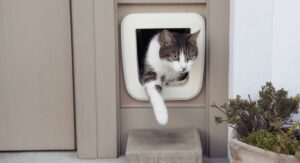Your cat stares longingly out the window, hoping to one day explore the outside world. Pet parents often find that transitioning their cats to an indoor-outdoor lifestyle is far more enriching than keeping them cooped up in the house. A romp through the neighborhood can give your kitty some much-needed independence. However, it’s also worth noting that indoor-outdoor cats encounter a lot more threats than their indoor-only counterparts. Gear up your cat for the great outdoors by incorporating these tips into their regular health routine.

Cat Climbing Thru Pet Door
Spay or neuter your cat: Before your kitty gets free roam, take them to the vet for a spay or neuter procedure. Intact cats are more likely to wander far from home in search of a mate. This increases their risk of getting hit by a car or attacked by other neighborhood cats. Spayed and neutered cats have a suppressed reproductive drive, which keeps them close to home and out of harm’s way. If you have a female cat, getting her spayed will also protect you from taking care of unwanted litters of kittens.
Update your cat’s vaccines: All cats need their vaccines, but this procedure is even more important for indoor-outdoor cats. Cats that venture outside have a much greater risk of contracting diseases from strays and wild animals. What’s more, infected cats can pass some viral infections onto human family members when they come back inside. Your indoor-outdoor cat will need the typical round of vaccines, a monthly flea and tick treatment and an extra shot for the feline leukemia virus.
Get them a microchip and ID tag: Cats may become lost or injured during their outdoor excursions. If someone finds your cat, they need a way to contact you so your fur baby can return home. A microchip is the only tamper-proof method of proving ownership. When a vet scans a microchipped cat, the owner’s name and contact information will show up in their database. Good Samaritans can also contact you directly when your cat wears an ID tag with your name, phone number and address. Collars with tags also show people that your cat belongs to someone and isn’t a stray—just remember to buy a breakaway collar so your kitty can’t get snagged!
Build an outdoor cat shelter: An outdoor shelter is essential in case bad weather hits or your cat wants to stay outside overnight. A shelter can also deter your indoor-outdoor cat from seeking warmth near a car’s engine. Build a sturdy wooden shelter that blocks out the harsh elements and stock it with blankets, toys and a cat bed. While cats are capable of surviving in the wild, extremely hot or cold weather can be dangerous for them. Bring them inside when a snow storm or heat wave is on the radar.
Keep food bowls inside the home: You should always place a water dish outside, especially during the hot summer months. However, food bowls need to stay inside so you don’t attract wildlife or stray cats. Keeping food indoors helps you monitor your cat’s calorie intake and gives them a reason to come back home. Stick to a regular feeding schedule to keep tabs on your kitty and make sure they don’t wander too far away.
Clean up toxins around the yard: Indoor-outdoor cats are more likely to encounter fertilizer, pesticides, road salt and antifreeze spills. All these substances are extremely poisonous to cats. Yard products stick to a kitty’s paw pads, and cats may ingest the toxins when they groom themselves. Clean up spills, switch to pet-friendly antifreeze and keep your cat inside while treating the lawn.
Maintain a comfy indoor space: There are times when indoor-outdoor cats want to enjoy the comforts of domestic life. Make sure your cat has access to food bowls, litter boxes, toys, scratching posts and bedding inside the home. Your fur baby might want to become a full-time outdoor cat if they can’t find the essentials in your living space. Provide everything they need, and your cat will achieve the right balance in their indoor-outdoor lifestyle.
It can be safe to let your cat enjoy a bit of freedom outside. Exploring is in a cat’s nature, and venturing outside helps them stay active and stave off boredom. Of course, pet parents should know that having an indoor-outdoor cat is more complicated than opening the front door. Take care of your kitty’s health and carefully weigh the risks to ensure they always return home safe and sound.
Dr. Jan Huntingford has been in veterinary practice for over 30 years. Since receiving her Doctor of Veterinary Medicine at the Ontario Veterinary College, University of Guelph, she’s founded two veterinary clinics and lectured extensively on pet herbal therapy, nutraceuticals, acupuncture, rehabilitation and pain management. Courtesy of Pet Wellbeing.
